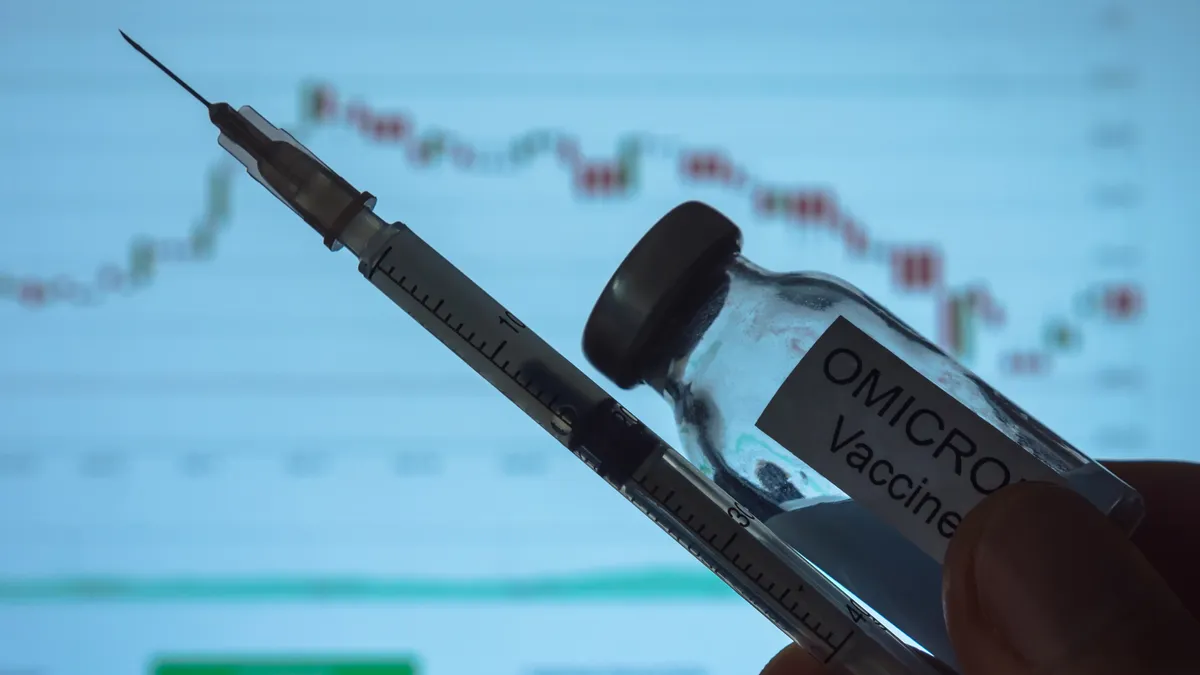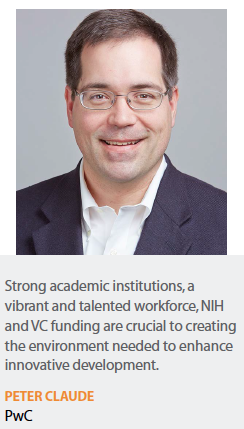 There is no disputing that the top two centers of R&D excellence in the country are San Francisco and Cambridge, Mass. However, there is much friendly debate between the two locations on which hub actually takes first place. While Bloomberg Business recently ranked Massachusetts No. 1 for innovation, San Francisco was ranked a close second. MassBio reports that venture investment in all of Massachusetts rose to a record $2.1 billion in 2015. According to the San Francisco Center for Economic Development, the biotechnology and life-sciences sector yielded $95 billion in economic activity and almost $30 billion in income, and was responsible for approximately 300,000 jobs.
There is no disputing that the top two centers of R&D excellence in the country are San Francisco and Cambridge, Mass. However, there is much friendly debate between the two locations on which hub actually takes first place. While Bloomberg Business recently ranked Massachusetts No. 1 for innovation, San Francisco was ranked a close second. MassBio reports that venture investment in all of Massachusetts rose to a record $2.1 billion in 2015. According to the San Francisco Center for Economic Development, the biotechnology and life-sciences sector yielded $95 billion in economic activity and almost $30 billion in income, and was responsible for approximately 300,000 jobs.
“The one obvious difference between the two locations is the weather," says Dr. Andy Plump, chief medical and scientific officer, Takeda, who is currently located in Cambridge. “It’s much better in Boston, of course, than San Francisco."
Sara Radcliffe, president and CEO of California Life Sciences Association (CLSA), agrees that both centers are thriving and contain the same elements: proximity to academia, a vibrant talent pool, and an eager venture capitalist community. Although currently located in San Francisco, Ms. Radcliffe has spent time in both hubs.
“I spent my college years in Massachusetts and I vividly remember pulling on boots and walking through the ice and snow," she says. “Massachusetts institutions are stellar from an academic point of view, but California is pretty hard to beat in terms of the weather, as well as the proximity of world-class institutions such as Berkeley, UCSF, Gladstone Institutes, and Stanford. For companies looking to enter into important new partnerships with academic institutions, I think it’s pretty tough to beat the Bay Area."
Boston may come up short in terms of sun, but the innovation coming out of Kendall Square is due to a perfect storm of talent, funding, academia, and science.
“The weather here is not great, and the traffic is even worse," says Robert Coughlin, president and CEO, MassBio. “So why do we continue to grow at record rates? It’s because the workforce is here. The partnerships with government are here.
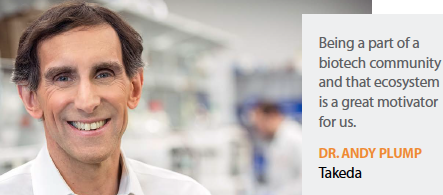 The infrastructure is here. The finance opportunities are here. And the science is here. All of these are necessary for a great biotech hub.
The infrastructure is here. The finance opportunities are here. And the science is here. All of these are necessary for a great biotech hub.
“I think the reason Massachusetts is known as the best place in the world for this business is because we have all of the ingredients required, so that we can be successful," he says. “We do a great job translating science and research into companies, and that’s really what differentiates us from a lot of the other parts of the country. It’s the amount of companies that we create here and we can do that because we’re No. 1 per capita in NIH funding and we’ve got a robust venture capital community that understands this complicated industry and how it works. We’ve got a big bench, a great number of seasoned veterans who grew up at the Genzymes, Biogens, and Millenniums of our region."
The San Francisco / Cambridge Impact
There’s no question that these two hubs and the states they are in are the major drivers for global biotechnology innovation. Between them, they employ about one-third of all biotechnology employees in the United States, receive half of all U.S. biotech investments, and accommodate a quarter of all U.S. biotech companies.
According to a recent report by CLSA and PwC US, the California life-sciences industry as a whole — not just the Bay Area — has 1,269 new medicines in the development pipeline. In the Bay Area alone, there are more than 68,300 direct life-sciences jobs, and an average annual salary of $162,226. Life-sciences VC investment in the Bay Area is $3.1 billion and projected to reach $4 billion this year. The Bay Area consists of 1,662 life-science companies, which employ more than 164,000 people.
The 2016 MassBio Industry Snapshot shows over 10 years, Massachusetts’s biopharma manufacturing employment has grown by 34% to 10,616 jobs statewide in 2015. The report also highlights that venture investment in Massachusetts rose to a record $2.1 billion in 2015, with Massachusetts receiving 28% of all VC dollars in biotech in the United States.
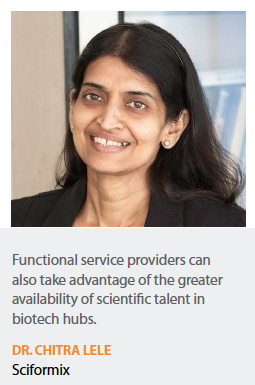 In 2015, 57% of all Massachusetts biotech companies receiving venture capital were located in Cambridge. According to the report, the Boston-Cambridge biotech area holds 250-plus biotech companies, the top four NIH-funded hospitals in the United States, and 48 colleges.
In 2015, 57% of all Massachusetts biotech companies receiving venture capital were located in Cambridge. According to the report, the Boston-Cambridge biotech area holds 250-plus biotech companies, the top four NIH-funded hospitals in the United States, and 48 colleges.
Dr. Lesley Stolz, head of JLABS California, has worked in both hubs and when she was seeking new employment opportunities several years ago, it didn’t matter to her which hub she ended up in, as long as it was one or the other. She wanted to work within either of the vibrant communities to take advantage of the motivational vibe, partnering capabilities, and the potential for recurring employment.
“I think both these hubs have really great advantages and distinct challenges," Dr. Stolz says.
One of the great advantages of a hub, she says for both small and big companies is the pure concentration of science and talent.
“These are incredible communities that allow for scientific exchange as well as human resource exchange," she says. “However, this is also one of the challenges. Companies can sometimes have trouble hanging on to talent because employees have the opportunity to jump from job to job — without having to relocate — in order to follow exciting science."
Ample opportunity for employment is a plus, Ms. Radcliffe says.
“The sheer number of life-sciences jobs in the Bay area — currently more than 68,000 — gives people comfort that if their current job falls through, which can be a legitimate concern with entrepreneurial startups in the life-sciences, there will be other opportunities," she says.
Ironwood Pharmaceuticals, which was born out of the Whitehead Institute at MIT, put roots down in Cambridge almost 20 years ago, when the company was first called Microbia. Along with his co-founders Peter Hecht and Todd Milne, Brian Cali, senior VP, R&D strategy and external innovation, decided that Cambridge was a great location for their company due to the proximity to collaborators and key scientific advisors, and a ready-to-occupy lab space.
“These allowed us to hit the ground running on research while getting communal support for things like shipping and receiving and facilities that were important but admittedly not top of our mind at the time," Mr. Cali says.
Much has changed since December 1998 for Ironwood, and for Cambridge.
“We’ve grown from a 13-person start-up to a commercial biotechnology company with two marketed FDA-approved 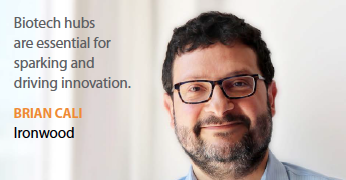 products, a robust pipeline, and an employee base almost 700 strong, with about 400 folks in Cambridge and about 300 in our national salesforce," he says.
products, a robust pipeline, and an employee base almost 700 strong, with about 400 folks in Cambridge and about 300 in our national salesforce," he says.
And Cambridge, while a center for innovative science for quite some time, has seen explosive change in those same 20 years.
“On a short walk within four blocks from Ironwood headquarters, I can easily count a dozen five-plus-story buildings, filled with biotech and pharma companies, that weren’t even buildings when we started," Mr. Cali says. “In most cases, they were vacant lots. “Now they are thriving centers of science and biomedical innovation. It’s just incredible."
Mr. Cali says Kendall Square has been a great location for Ironwood as it offers an attractive environment for employees in the center of a community that fosters innovation.
“We have some of the largest biotech and pharma companies represented here, along with numerous start-ups, and it makes for an exciting mix," he says. “You go to lunch around here, and not infrequently you are sitting next to a Nobel Prize winner or two, CEOs of any number of startups, venture capitalists, or some really creative young scientists. All around, there are conversations about the latest scientific breakthrough, or a new business idea being hatched, just like we did sitting over breakfast at a local coffee shop."
Due to its central location, Ironwood is able to host many industry events that allow for the exchange of ideas between peers.
“This constant flow of ideas makes us better as a community and as an industry," he says.
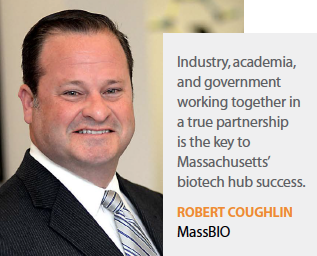 Dr. Plump from Takeda agrees: “Being part of a community that’s so dynamic pushes us to be great. Witnessing what’s happening and not just reading about breakthroughs but being a part of a dynamic community and ecosystem are great motivators."
Dr. Plump from Takeda agrees: “Being part of a community that’s so dynamic pushes us to be great. Witnessing what’s happening and not just reading about breakthroughs but being a part of a dynamic community and ecosystem are great motivators."
Dr. Plump views Takeda’s location on Massachusetts Avenue near MIT as an opportunity to build out the company’s R&D presence in Cambridge. Over the past couple of years, Takeda has been working at transforming the Cambridge location into its predominant R&D center. The goal is to be more open and externally facing. Dr. Plump says every day Takeda’s labs play host to scientists from MIT or Harvard or from a biotech company with which it is partnering. And the reverse is true; every day Takeda scientists are working in the laboratories of partners or potential partners.
“I’m here, as is my entire leadership team, and our intent is to be positioned in the center of healthcare innovation in the world and to leverage this position to drive our future," he says.
According to Dr. Stolz, the collaborative spirit in San Francisco is long-standing, and has been fostered for many years by the academic centers.
“In the Bay area, Stanford, UCSF, UC Berkeley, and UC Santa Cruz have all created a very strong and long-lived environment that promotes collaboration and communication in very open ways," she says.
Dr. Stolz explains that in the Bay area people have been raised in a “let’s-all-work-together" way because there is a general consensus that there are important things to be done and there is a greater chance of success by working together rather than taking a proprietary approach to problem-solving.
Dr. Stolz feels that the Boston area is just starting to warm up to the idea of precompetitive collaborations.
“There has been a lot more competition between the Harvards and the MITs and the companies that were being spun out 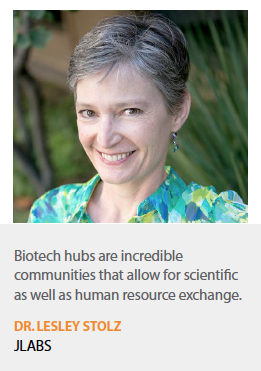 of them; they were historically quite closed and focused on their own science," she says. “This has started to change and the academic centers have opened up in terms of collaboration, but there’s a shorter history of broad collaboration in Boston than in the Bay area, where this approach is much more ingrained."
of them; they were historically quite closed and focused on their own science," she says. “This has started to change and the academic centers have opened up in terms of collaboration, but there’s a shorter history of broad collaboration in Boston than in the Bay area, where this approach is much more ingrained."
Dr. Plump remembers when the San Francisco area had more start-ups and venture capital dollars than Boston, however, more recently the venture community in Boston has changed its mindset and is committing more Series A funding.
“Rather than hunters, these venture capitalists became farmers; they have been planting seeds and investing in very early ideas," Dr. Plump says. “About six years ago or so, Cambridge became a sustainable ecosystem with the right talent, great academic centers, robust venture community, and pharmaceutical companies populating the region."
“California has a very long history of attracting pioneers, rebels, and people who are willing to take a very long journey on the slim chance of success, which is what a lot of life-sciences research is," Ms. Radcliffe adds. “California as a whole benefits from that pioneering spirit in the life-sciences sector."
San Francisco also benefits from the proximity of Silicon Valley, which produces collaborations between life-sciences companies and tech companies such as Google, Lumosity, and Proteus Digital Health.
“There are many world-famous tech companies in the Bay area and as we think about the development of digital health and the ways in which the delivery of healthcare will change in the future, this creates a unique and vibrant environment," Ms. Radcliffe says. She views this as a major advantage to the Bay area.
“The thing that is most remarkable is the interconnections between the life sciences and technology," she says. “When you consider what it takes to do life-sciences research, technology can be really transformative and the Bay area holds the lead because the top companies all have a presence somewhere in or near the Bay area."
According to CLSA’s 2017 California Life Sciences Industry Report, California had the highest digital health venture capital investment in 2016, at $1.6 billion. The Bay Area also lead the state in VC funds attracted for the life-sciences space, with $3.1 billion.
Elements That Make Hubs Work
Peter Claude, partner, pharmaceutical & life sciences advisory, PwC, says there are several elements that have to be present in order for a biotech center to thrive. He lists strong academic institutions, a vibrant and talented workforce, NIH funding, and venture-to-venture funding as crucial to creating the environment needed to enhance innovative development.
Despite advances in telecommunication and remote teams being the norm, there’s a distinct advantage to proximity to academic centers and a robust workforce that is conducive to research and innovation, says Chitra Lele, Ph.D., chief scientific officer, Sciformix.
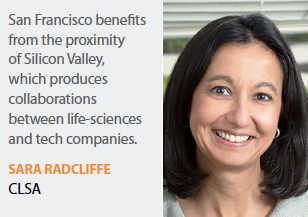 The local biotech industry in Cambridge benefits from having NIH-funded universities, such as MIT, Harvard, Boston University, and Tufts University. Several startups have emanated from these institutions.
The local biotech industry in Cambridge benefits from having NIH-funded universities, such as MIT, Harvard, Boston University, and Tufts University. Several startups have emanated from these institutions.
“Functional service providers can also take advantage of the availability of scientific talent in the region and provide services to some of the local biotech companies," Dr. Lele says. “Additional partnerships can be spawned from the meetings, forums, and conferences that are hosted from the area such as MassBio’s Annual Meeting, TIE, BioTech Tuesday, etc. Such events are becoming more relevant with growth of local biotech companies."
Dr. Stolz agrees that physical proximity to thought leaders helps to build stronger relationships faster through face-to-face meetings.
“For Johnson & Johnson, it’s really important to have one location where everybody can come and know that they’re going to find the people who they need to build collaborations," Dr. Stolz says.
Proximity to partners and VC firms has always been a factor in driving innovation at Johnson & Johnson Innovation and each of its innovation centers are located in thriving hubs — in Boston, San Francisco, London, and Shanghai.
“Face-to-face interactions are important for building trust and building relationships that benefit from sharing information and collaborating on science," Dr. Stolz says.
The Elements of Success
Our experts say academic institutions are central to the success of a biotech hub.
“Strong academic centers produce great scientists, great scientists produce great ideas," Mr. Claude says. “Access to NIH funding helps turn those great ideas into potential products. Venture capitalists have helped turn those potential products into life-changing treatments. And years of doing this has led to a talent base in the market that knows how to take technologies from ideas to treatments. I think when all of these elements are combined, there is a successful biotech hub."
“Excellent academic institutions produce well-trained scientists who continue in academia, join industry, or start their own companies," Ms. Radcliffe says. “This process leads to new innovations and investments to transform innovative ideas into products, generating income, employment, and life-changing technologies. These efforts help power our economy, support to improve health for millions around the world."
“There’s no doubt that the quality of the academic institutions and research hospitals mattered greatly in getting the life-sciences industry in Cambridge started on the right foot," Mr. Cali says. “They attract incredibly talented people to our area, and further a mindset of intellectual curiosity, innovation, and thinking big that is then seeded into the companies that grow up around them."
Another major success factor is access to and proximity to VCs that understand the nature of the life-sciences industry. VCs are crucial to the equation as they provide funding that turns ideas into products. According to Mr. Claude, the value of venture capital entities to biotech hubs stems from their willingness to take risks; they know how to oversee companies and help to champion and support them during the commercial period and, most importantly, they provide money to both early-stage and late-stage companies.
“Being in the same vicinity benefits VCs and their portfolio companies tremendously, as they can meet regularly and walk the halls and get to know the ins and outs of the business." Mr. Claude says. “That’s why West Coast VCs fund West Coast companies, and East Coast venture capitalists fund East Coast companies. There is certainly some cross-pollination between the two, but most portfolios are heavily weighted toward their home markets."
Proximity to venture capital is one of the big drivers for a concentrated biotech hubs, but this makes it more difficult for smaller hubs to attract VC potential.
“At JLABS we are trying to catalyze hubs in places where there’s excellent science, such as Houston and Toronto, but sometimes it’s challenging to get the VCs to participate," Dr. Stolz says. “Therefore, startups located within a hub have a better chance of getting funded."
In an aside, Dr. Stolz says she has noticed a new trend developing regarding VC interaction with biotech startups and companies. As a result of the many VC/company partnerships, some scientists and entrepreneurs are discarding their lab coats and joining the VC side of the business.
“Venture capitalists now have access to people who are knowledgeable about science and risk management and who have biotech operating experience," she says.
New Trends
Biotech centers are not only creating great science, they are also causing a ripple effect across the industry in terms of impacting pipelines and the way the industry does business.
Dr. Stolz believes collaboration will remain key throughout the industry, but especially within the hubs. She has witnessed an increase in the number of interactions between the universities and experienced entrepreneurs as they strive to commercialize the exciting innovations in science.
“With greater concentration in each of the hubs, it’s becoming more common for innovation to move out of the universities and into companies for commercialization," she says.
PwC’s Mr. Claude notes that more companies want to take their product all the way through to launch. This trend contrasts greatly from 10 years ago, or less, when all entrepreneurs wanted was to get a product to Phase 3 and then sell their product to a larger company for commercialization.
“Five to 10 years ago companies just wanted to get the product to a point in which another company would want to buy it," Mr. Claude says. “But now, companies want to take their product all the way to launch, which has resulted in more commercial experience in the Bay Area than ever before."
This dynamic environment perpetuates a cycle of discovery and entrepreneurial buzz.
“This is an exciting change, because the young biotech companies are making a name for themselves by launching their first products and getting a big news splash," Mr. Claude says. “This creates more and more interest and buzz around the market. And if the company does get bought, after the acquirer comes in, most of the people form another new company and the cycle perpetuates."
Mr. Coughlin from MassBio has seen two big changes in the past decade.
One change is that big pharma is moving into biotech hubs. These companies want to have an R&D presence where the action is and they want to benefit from external innovation.
“Many of the big pharma companies have outsourced some of their pipeline to smaller companies," he says. “The second piece is that in Massachusetts the government has become a partner. As I’ve said, industry, academia, and government all working together in a true partnership is the key to our success."
Mr. Coughlin believes what’s next for the Commonwealth is digital health, precision medicine, gene therapy, med-tech, diagnostics, companion diagnostics, devices, etc.
“We’ve seen significant growth in these areas," he says.
Mr. Cali from Ironwood says over the past 20 years he has seen Boston’s and Kendall Square’s universities and research hospitals act like a magnet drawing venture capitalists to the area and providing funding to allow the necessary time for life-science companies to advance
“Twenty years ago, pharmaceutical companies were well established in New Jersey, and California was getting attention for its budding life-sciences communities," he says. “Over these years, I’ve had the benefit of seeing Boston become a major biotech hub.
“From my vantage point, biotech hubs are essential for sparking and driving innovation," Mr. Cali continues. “It’s no surprise that like-minded people with a similar passion for the life sciences come together. But when the right elements — the talent, the institutions, the capital — are located in a collaborative and intellectually curious environment, there is an opportunity to hit a critical mass; the energy and momentum build upon themselves." (PV)









